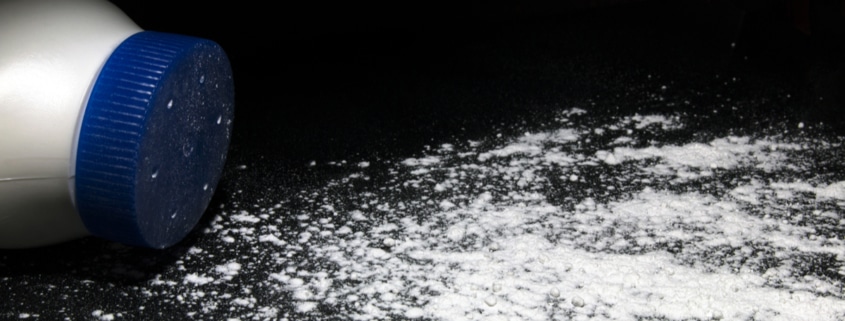Talcum Powder Lawsuits Prove Strong Cancer Risk
Johnson’s Baby Powder has been a staple in many households for over a century, but recent talcum powder lawsuits against the conglomerate have exposed the cancer risks associated with its use.
First marketed by Johnson & Johnson (J&J) in 1894, Johnson’s Baby Powder became a staple to prevent diaper rash, but other uses for the powder were soon discovered, and it became widespread in many other products marketed to consumers.
Baby powder is known to be an absorbent, light substance, making it ideal for many uses. Besides its use as a baby powder, the company marketed the powder as a feminine hygiene product for women because of its ability to absorb moisture and prevent rashes. It was also formulated for use in cosmetics, deodorants, and dry shampoos. Innovative consumers found it useful for everything from keeping playing cards from sticking together to freshening shoes.
The product contains talc, a soft mineral that is mined, then ground into a powder referred to as talcum or talc. Talc by itself is not known to be harmful. The issue is that it occurs naturally in the ground along with asbestos, which is a known cancer-causing agent.
It has been clearly shown that asbestos causes cancer, including ovarian and lung cancer, mesothelioma, and laryngeal cancer. Because talc and asbestos are mined together, this close link may be the source of cancer risk when using talc products.
Whether talcum powder increases the risk for cancer has been studied and discussed for many years. Recent developments make it more important than ever for consumers to understand the controversy that’s been brewing around talcum powder.
As early as the 1950’s, laboratories found contaminants in talc used by J&J that appeared to be consistent with asbestos, which is often described as fibrous or needle-like. Since that time, studies by several laboratories also showed these impurities.
Scientists started questioning the relationship between talc and ovarian cancer as early as 1971. In that year a scientific paper reported the results of a study that examined tissue from ovarian tumors. The scientists found talc particles in the tumor tissue, and pointed out the connection between talc and asbestos. Other studies demonstrated the movement of talc particles to the ovaries. This sparked curiosity about the connection with ovarian cancer.
Research from several other studies since then on women with ovarian cancer who used talcum powder has shown everything from no risk to a moderate risk. One study that looked at over 8,000 cases found a risk of ovarian cancer between 20 and 30 percent in women who used talcum powder for feminine hygiene.
The link between talc and asbestos is troubling, but it’s notoriously difficult to prove what may cause a certain type of cancer.
Despite the studies and mounting evidence of the link between talcum powder and ovarian cancer, J&J continued to market it, and insisted that its powder did not contain asbestos. However, a recent investigation by Reuters reported that the company may have known their talcum powder was contaminated with cancer-causing asbestos. According to this report, company documents uncovered as a result of talcum powder lawsuits show that from 1971 to the early 2000s, the talc J&J used would sometimes test positive for asbestos.
Internal J&J reports reviewed during this investigation show that most of their testing didn’t show any asbestos, but also noted that J&J’s test methods had limitations when detecting trace amounts of asbestos. In addition, the company tested only a small fraction of its talc.
Other documents uncovered by Reuters show that J&J knew that three tests by different labs between 1972 and 1975 found asbestos at levels that were described as “rather high.” Nevertheless, J&J told the FDA in 1976 that it did not find asbestos in any sample of talc from December 1972 to October 1973.
Further, Reuters uncovered that company officials discussed how to deal with the problem in company documents and reports during the 1970s and 1980s. While they were talking about it, they did not disclose their concerns to consumers or to regulatory agencies.
Over the past few years J&J has been hit with multiple lawsuits alleging that its talc products caused cancer. Juries have awarded over $5 billion to plaintiffs since 2016, and the company is currently facing nearly 13,000 claims with up to $20 billion at stake. In February the Securities and Exchange Commission and the Justice Department issued subpoenas to J&J related to these lawsuits.
Concerns about talc contaminated with asbestos go beyond baby powder. Recently the FDA alerted consumers not to use three cosmetic products—eye shadows, contour palette, and compact powder—from Claire’s Stores, Inc., due to these products testing positive for asbestos.
J&J denies that the company knew that its baby powder contained asbestos. They maintain that their baby powder is free from asbestos and does not cause cancer.
People who are concerned about a serious cancer risk from talcum powder should consider staying away from it, or at least using it cautiously, until more scientific evidence of the link between talc and asbestos is available.






